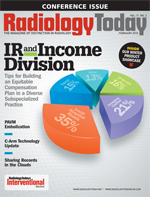 February 2010
February 2010
Blu-Ray Archiving — Is It the Heir Apparent to MO Cartridges?
By David Yeager
Radiology Today
Vol. 11 No. 2 P. 6
Off-site and Web archiving have become increasingly popular in the last few years, but for low-volume facilities and imaging departments, on-site archiving can still make sense. In many cases, optical drives such as Sony’s Magneto Optical (MO) have worked well for archiving images from small PACS systems. MO dominated this market niche for many years; however, now that it’s at the end of its life cycle and no longer available, there is no clear successor. To address this market, Panasonic is adapting its Advanced Disc for Archive (ADA) Blu-ray storage technology to accommodate medical images.
“They wanted to come out with a solution that sort of matched in the workflow way as much as possible [to] the way that people were used to using MO,” says Dave Thomson, vice president of sales in the United States for QStar Technologies, which is developing software for the ADA system. “And that typically meant use of the cartridge-based media so, for the last year or so, they’ve been designing a new drive which uses this Blu-ray media in a cassette case.”
For rollout, the focus is on original equipment manufacturer (OEM) customers who sell PACS and modalities that will work with the drives. Sony’s MO was typically sold to OEMs and built into the modality systems of PACS vendors and modality providers. That setup is changing as several Panasonic customers, particularly GE, requested that the new system be an external drive. “[The OEM customers] had to go back for FDA approvals more regularly than they really wanted to and therefore they’d decided to request that all storage for those modalities be external to the modality system itself,” says Thomson. “And that caused Panasonic a bit of an issue because they were hoping just to sell a bare drive and now they were being asked to develop a solution which was network attached.” So Panasonic contracted with QStar to provide software and Rorke Data to provide a server platform.
The ADA drive is vendor neutral; it can be configured to work with any PACS. It is designed to connect to multiple modalities within a facility or department. The initial product will be CT compatible, but Thomson says any modality can be included if there’s an OEM partner willing to take on the product. “We can custom-make the solution to fit their requirements,” he says. “It’s not a single product that fits all. You can actually tailor-make it, adding different amounts of [storage] cache. The workflow can be changed slightly as well, depending on what the requirements are.”
Depending on the system’s configuration, multiple layers of hard disk cache can be added. “And that means that a significant percentage of the data could be coming back from fast-response hard disk,” says Thomson. “You could then also have a second tier, which would be the secure archive on the optical media.”
Additional uncartridged spinning disk media have grown in popularity, but some users prefer cartridge-based media. “It seemed that organizations were a little bit reticent to use uncartridged, bare media in some circumstances because touching the bare media with fingers and so on can cause degradation of data within those disks,” Thomson says. “They’re all well and good if you’re keeping it within a library environment, but as soon as you want to take it out of the library, then managing bare media becomes relatively difficult.” Blu-ray cassettes can be bar coded for efficient cataloging.
Not Just for Movies
Because it is commonly associated with movies, using the Blu-ray format for medical image archiving may seem unusual, but Thomson says companies are increasingly including it in file storage systems. “It seems to be becoming more and more prevalent. It lends itself to archive storage significantly well because it has that long-term data life of optical media,” he says. Optical disks—DVDs and CDs—can be expected to last 50 years or more. And, he notes, the Blu-ray standard is highly secure.
Thomson thinks Blu-ray will have staying power. “The Sony drive itself went through five different iterations, from 650 MB in the beginning, which was in the 1980s, to 9.1 GB, which is the system they’re going through now, so that’s more than 20 years. The Blu-ray standard should be equally as prevalent because there have been significantly more of those sold than were ever sold with Magneto Optical,” he says. “The new solution, the ADA drive, holds 50 GB. And they already have a road map to 100 [GB].”
The product is expected to be beta tested during the first quarter of 2010 and available sometime during the second quarter. And although much of the planning for the ADA drive is complete, Thomson says Panasonic, QStar, and Rorke have no plans to sell their own drives any time soon. “That doesn’t mean to say that we won’t be doing a solution for the general public … using a different brand eventually. But the first step is definitely OEM organizations to take the product on,” he says. “In the past, we’ve seen some of them actually want to brand it themselves.”
— David Yeager is a freelance writer and editor based in Royersford, Pa.

